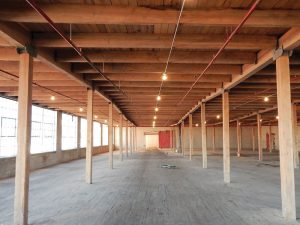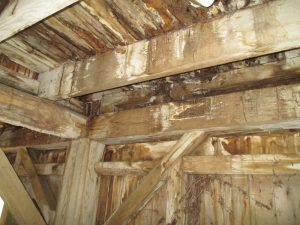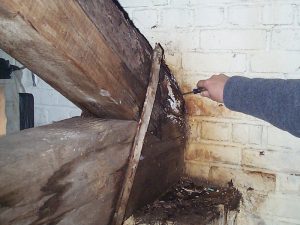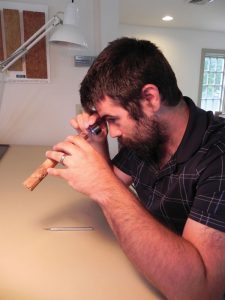Man has been building timber structures throughout Europe and Asia for over 4,000 years. In North America, timber structures have been built since the first Europeans arrived 400 years ago. Consequently, there are thousands of old timber structures still in service.
When restoring or renovating an old timber structure, or when adapting it to a new use, it is often necessary to evaluate the structural integrity and load-carrying capacity of the timbers. When structural deficiencies are identified, structural remediation may be in order. If the structural evaluation is based on overly conservative or unrealistic assumptions, the resulting remediation program may be excessively costly and may result in unsightly and unnecessary alterations.
Deterioration and Impairment
It is rare to find an old timber structure that does not exhibit some degree of deterioration that may affect the capacity of the structure. Timber deterioration may be caused by fungal decay, insect infestations, structural overload, or mechanical damage. The reduction in structural load resistance associated with timber deterioration is referred to as impairment.
Fungal decay, often called decay or rot, is by far the most common type of timber deterioration. Rot is caused by a fungus that feeds on the lignin and cellulose fibers of the wood. There are a variety of rot fungi types. Brown rot is the most common form of decay, while wet rot and white rot are not uncommon. Dry rot is a form of brown rot, but the term is frequently misused since many engineers believe all types of decay are dry rot. Precise identification of fungi is difficult, but, fortunately, it is not necessary for most projects.
Several species of insects bore into or feed on wood tissue. In North America, the most common are termites, powderpost beetles, carpenter ants, and carpenter bees. For purposes of evaluating the structural load-carrying ability of an impaired timber, the portion of the timber containing decay or insect damage is typically treated as a void.
Condition Assessment
The condition assessment of a timber structure begins with a visual examination to evaluate the extent of deterioration and to identify signs of structural distress.
To properly locate the damaged areas in the structure, an understanding of the places where rot is likely to occur is essential. For example, areas where persistent roof leaks are evident or where timbers are pocketed into a masonry wall are often more susceptible to rot. For a more in-depth evaluation of timber condition, an awl is a simple and indispensable tool for probing the surface of a timber to identify the depth and extent of deterioration, from either rot or insect damage. Any portion of the wood that can be penetrated with modest pressure from an awl should be assumed to be impaired.
There may be deterioration present within the core of a timber that cannot be seen and is too deep to probe with an awl. Sounding with a hammer can be effective at identifying hidden deterioration. The sound that the timber makes when struck with the hammer is an indication of the soundness of the timber. A dull thud is an indication that there may be internal deterioration.
Some form of nondestructive evaluation (NDE) may be warranted if hidden deterioration is suspected. There are some sophisticated NDE systems such as ultrasonic stress-wave measurements that have been used with limited success in evaluating deteriorated timbers. Although not entirely non-destructive, resistance drilling is an effective method that leaves minimal evidence of the test.
Resistance drilling creates a small diameter hole (typically 1⁄8 inch) in the timber, and the torque required to advance the drill bit is measured and plotted versus depth. Rotted or insect-damaged areas clearly show up.
It is worthwhile to measure the moisture content of the timbers with a hand-held moisture meter. A high moisture content (above 30%) is an indicator that conditions are conducive to fungal decay.
Signs of structural distress such as fractured, split, or deflected timbers should be identified. Particular attention should be paid to connections and joinery since that is where most structural failures initiate.
Seasoning checks are not splits and are often misidentified as structural defects. Checks are ordinary timber features and are not defects. No reduction in design bending strength is warranted for a checked timber. Checks typically do not require remediation.
Structural Evaluation
In the structural evaluation of an existing timber structure that has been in service for decades, the first step should always be an assessment of the structure’s performance. If the structure is reasonably free from damage or deterioration and has been safely supporting the imposed loads with no sign of structural distress, and no change of use is anticipated that would impose higher loads than have been carried in the past, there is usually no need to embark on a detailed structural analysis or to consider structural remediation.
The National Design Specification for Wood Construction (NDS) is a reliable standard for the structural design of new timber structures but is not a good standard for predicting the actual behavior or adequacy of existing structures. Within timber grade classifications, there is a wide variation in strength properties. The published allowable stress values are calculated based on the weakest 5% of timbers of a given species and grade. Consequently, the published reference design values are very conservative for most of the timbers that are in service.
For adaptive reuse of an old timber structure where the new use has higher loading requirements than the previous use, a structural analysis is appropriate. One challenge when determining the load-carrying capacity of an existing timber structure using analytical techniques is determining what allowable stress values are appropriate. Engineers who are not experienced evaluating timber structures may make erroneous assumptions about the timber species and grade that can lead to flawed conclusions and misguided recommendations. For instance, if for expediency, Spruce-Pine-Fir (SPF) No. 2 grade is assumed for analysis purpose, but the actual timbers are Southern Pine conforming to a Select Structural grade, the analysis will be overly conservative and will significantly undervalue the structure.
Identifying Timber Species and Grade
The timber species must be identified before design values can be determined. Some timber species, particularly hardwood species, have distinctive characteristics that can be visually identified by a trained eye. However, since timbers in existing structures are often aged, stained, dirty, or even painted, it is usually necessary to take specimens of the timbers and examine the anatomical features of the wood with a hand lens or under a microscope to determine the wood species.
The Forest Products Laboratory provides a wood species identification service, but this service is not intended for large quantities of samples or extensive ongoing use by private firms. It is usually more expedient to engage the services of a wood scientist or a commercial service to identify the species based on small specimens taken from the structure.
Once the timber species has been identified, the next step is to assign a grade to the timber. It would be unusual to find a grade stamp on timbers unless the structure is less than 50 years old. Published grading rules are intended for the grading of freshly sawn timbers at a sawmill. The grading rules have restrictions on many timber characteristics (such as stain, pitch pockets, and pinholes) that are primarily of cosmetic concern and have an insignificant bearing on structural properties. The strength defining timber characteristics are limited primarily to the slope of grain and knot size. Consequently, when performing in situ grading, greater emphasis should be placed on the slope of grain and knot size rather than cosmetic characteristics.
In assigning grades to timbers, in-situ grading follows the grading rules of rules-writing agencies such as the Northeast Lumber Manufacturers Association (NeLMA), the Western Wood Producers Association (WWPA), the Southern Pine Inspection Bureau (SPIB), or others.
Straightness of grain has a significant influence on the flexural or tensile strength of a timber. A timber with a 1:6 slope of grain has approximately 40% of the flexural strength of a timber with a straight grain. For flexural members, the slope of grain is most critical in regions of high bending stress. The slope of grain can safely be permitted to exceed grade limits in areas of little or no bending without requiring that the grade for the entire timber be reduced for determination of allowable bending stress.
Knots are a significant strength-reducing feature in timber due to the deviation of grain around the knot. When grading a timber, knots located in regions of high flexural strength are of the most interest.
There is a commonly held belief that old timber is stronger than new timber because the trees grew more slowly in the dense virgin forests of the old days and “they just do not grow them like they used to.” While there is some truth to that belief, it is not universally factual. It is generally true for softwood timber species, but it is not true of hardwoods such as oak. Slow grown oak timber is brash (less ductile) and weaker than fast grown oak.
In softwood timber, density often relates to the rate of growth, which is measured as the number of growth rings per inch along the radial axis. If there are more than six rings per inch measured on a radial line and one third or more “summerwood” (this is the less porous portion of an annual ring of wood that develops late in the growing season and is identified as a narrow dark band), Douglas Fir and Southern Pine are graded as “dense.” A “dense” grade designation relates to an increased allowable bending strength value in the NDS of between 15% and 20%.
Structural Analysis
Once the timber species and grade have been established, allowable stress values can be selected from the NDS. If the timber species is not one that has published design values, the design values can be calculated based on procedures described in ASTM D2555, Standard Practice for Establishing Clear Wood Strength Values, and ASTM D245, Standard Practice for Establishing Structural Grades and Related Allowable Properties for Visually Graded Lumber.
Allowable stress values should be adjusted based on the in-service moisture content of the timber. The published values in the NDS Supplement are based on timbers that are in the green condition with a moisture content above 19%. Timber gains strength and stiffness as it dries and seasons. Refer to TFEC (Timber Frame Engineering Council) Technical Bulletin 2018-9 for recommended adjustments to reference design values for bending in timbers with a moisture content of 19% or less.
It is essential to base the structural analysis on actual timber dimensions rather than tabulated nominal dimensions. The timber dimensions change as the timbers season and shrink. It is the actual dimensions that really matter.
As one becomes familiar with the imprecision involved in the grading rules for timber and the procedures for determining reference design values in ASTM D245, it becomes clear that, if a timber in an existing structure is found to have calculated stresses that exceed the design values given in the NDS Supplement, it does not necessarily mean that it is not capable of safely supporting the applied loads. It is a mistake to reject a member because calculated stresses exceed the design value associated with the given species and grade by relatively small amounts, on the order of 10 percent. For example, 50 psi calculated overstress in bending falls more or less within roundoff error for that property. Moreover, given that the design value is based on the 5th percentile exclusion limit, flexural stresses that are more than 100 psi above the design value might reasonably be considered acceptable for timbers in existing structures, particularly if the timbers are performing well.
Conclusion
If the timber structure is reasonably free from damage or deterioration and has been safely supporting the imposed loads with no sign of structural distress, and no change of use is anticipated that would impose greater loads than have been carried in the past, service stresses exceeding design values need not be reason for strengthening or replacement of the timber structure.
On the other hand, if timbers are exhibiting signs of structural distress or are severely deteriorated, remedial measures are appropriate.
This article contains excerpts from TFEC 3-2019, Guide to Structural Evaluation of Existing Timber Structures, published by the Timber Frame Engineering Council (TFEC). The full document is available at www.timberframeengineeringcouncil.org.■





